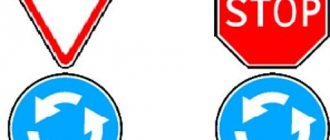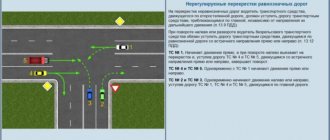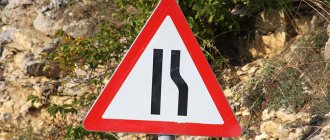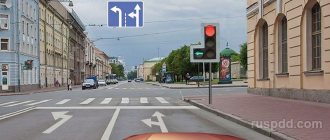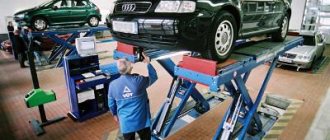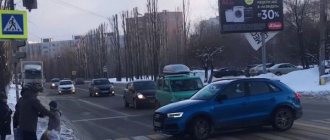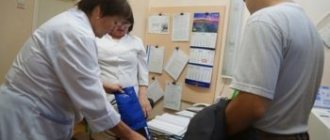What is reverse movement
Reversing traffic refers to a method of organizing traffic in which a car can move in one lane in different directions.
The main distinguishing aspect of such a lane is the ability to change the direction of the car depending on the situation on the road. The purpose of introducing such traffic was the need to relieve congestion in other lanes for faster and more comfortable movement of cars. Another common reason for using such movement is the need to repair roads or eliminate the consequences of a traffic accident. This band was introduced as part of an experiment in large cities of the Russian Federation.
The ways in which such movement is regulated deserve special attention.
Features of reverse movement
A road with reversible traffic is a section of the road with increased danger, on which there is a high risk of getting into a traffic accident. It is for this reason that a motorist who moves along such a lane must concentrate as much as possible on driving the car, without being distracted by conversations.
Driving along the lane can continue until the posted sign indicates the end of this road.
When driving on a reversible road, you must be careful when turning left and when changing lanes to the far right at an intersection. Even if the road is clearly visible, before turning the car to the left, you need to change lanes to the right. Compliance with this rule is monitored by traffic police officers at the exit to a two-way road.
According to traffic rules, you can change lanes onto a road with this type of traffic only within the visibility range of a traffic light. Accordingly, you can also change lanes only when the traffic light signal permits. If a prohibitory signal comes on, you must leave the lane as quickly as possible to avoid being involved in an accident.
Reversible traffic light, what is it?
Every driver has heard about the term “reverse movement”. However, not everyone has encountered it in reality. Reversing movement is often used at a certain period of time when it is required.
The need for these lanes arises on those sections of roads where traffic intensity changes throughout the day. So, for example, in the morning everyone rushes from home to work, and in the evening, vice versa. And in order to avoid hours-long traffic jams, special lanes are being introduced.
Traffic regulation is carried out by means of a traffic light, a traffic police officer or road workers. A reversible traffic light controls traffic in the lane above which it is located.
Sometimes these traffic lights are used in tunnels. Installed above the rows, they make it possible to regulate traffic on the lanes in a short period of time during road accidents or during repair work on the roadway.
Methods of organizing traffic on the reversible lane
Traffic in the reversible lane is limited in several ways.
Special road signs
Road signs are posted only before the start of the reversible road, as well as at each intersection and entrances to the lane from adjacent streets. There are several types of signs that are used to indicate reverse movement:
- Sign 5.8, which is installed at the beginning and end of the intersection if the lane continues further.
- Sign 5.9 is installed at the end of the reversible lane.
- Sign 5.10 indicates the possibility of entry from adjacent streets.
Sometimes reverse is only turned on on certain days or time periods, so other additional road signs may be used. In addition, traffic police officers can install signs indicating the direction of travel.
Road markings
The driver can determine that he is driving in a reversible lane by following the double broken line. The line can be drawn in two ways:
- On both sides of the road.
- Only on the left if there is a traffic light above the road.
Therefore, if while driving a motorist sees that there is a double broken line to his left, this means that this is a lane with traffic that can change depending on the traffic light signal.
In some cases, such a strip can also be used for classical markings to separate flows with different directions of movement. In order not to get confused as to whether the road is reverse or classic, you need to pay attention to the road signs.
Motorists may encounter some difficulties in the winter season, since the snow cover makes it difficult to see the markings. In such cases, traffic police officers have the right to install additional signs indicating the beginning of the reversible road. In particularly difficult cases, a traffic controller may enter the road.
Traffic light
For reversing, not an ordinary traffic light is used, but a special, reversible one. Such a traffic light can have several fields:
- A green arrow pointing down means you can drive in the lane.
- Yellow directed to the right or down – the driver needs to change lanes to the right, as the direction of travel will change in the near future.
- A red cross indicates that reverse movement is prohibited.
Most often there are traffic lights with two signals - red and green, which change depending on the situation on the road.
If the lane is on the left side and the traffic light is turned off, it means that the reversible lane is currently a classic lane and you can drive along it, observing normal traffic rules.
To monitor compliance with the rules, photo and video cameras are located along the entire reverse lane.
Types of traffic lights
In the everyday view in Russia, a traffic light is a three-section light signal that allows or prohibits driving. In fact, the traffic rules distinguish seven different types of lighting devices, each of which has its own nuances, and the driver must correctly interpret their meanings.
These include:
- The three-section has three segments in which green, yellow or red signals light up. Reflects permission or prohibition to travel along the highway.
- The two-section is equipped with only two segments in which red and green are lit. Typically used to organize single-lane alternate traffic, as well as when entering and exiting closed areas.
- With an additional section - used to indicate a permitted turn when the alternative signal of the main traffic light is on.
- Single-section serves as a complement to other designations. Usually there is either an arrow on it or a ban in the form of a red signal.
- For pedestrian crossings with the image of human contours. They can be automatic or manually controlled, when the green light turns on at the request of a person.
- For trams and at railway crossings. White traffic lights giving the right of way to vehicles depending on the type of signal.
- A reversible traffic light that regulates certain areas of traffic.
The traffic light has a priority position among all road symbols; it is necessary to follow it and only in case of breakdown or switched off mode, follow the road signs. Sometimes, for example, in the case of a reverse road, a disabled device changes the situation on the highway, giving the road markings a different meaning.
The yellow light gives information to the driver that the signal will soon change, but does not imply that it is already permissible to begin maneuvers on the road.
If there are reversible markings, but there are no traffic lights, then there is no need to enter the reversible lanes, marked with markings on both sides.
After reading this article, you will be able to easily determine whether there are reversible lanes on the road, as well as what their number is. Well, the next article in the series will look at road signs on roads with reverse traffic.
Good luck on the roads!
Fine for driving in the reverse lane
The Code of Administrative Offenses does not contain separate articles regarding penalties for incorrect driving in reverse. However, in practice, police officers manage to identify several similar violations for which punishment can be applied.
- The driver ignores traffic lights. Punishment for such an offense is possible in the case when a motorist drives into a reverse lane with a red traffic light above it. Liability for such a violation is 5,000 rubles or deprivation of the right to drive a car for up to six months. If the driver is caught with such a violation a second time, he will lose his license for a year.
- Avoid obstacles on the left side, cross the marking line and drive the car into the oncoming lane. For such a violation of traffic rules, the motorist is subject to administrative liability in the form of a fine of up to 1,500 rubles.
- Incorrect placement of a car while crossing an intersection is also punishable by a fine.
If such a violation was detected by a video camera, traffic police inspectors do not have the right to bring the driver to maximum liability in the form of deprivation of his license.
What penalties can be applied for driving into the reverse lane?
Violation of traffic rules may lead to a fine or deprivation of rights
There are no exact instructions regarding this type of movement, so its participants are punished with fines based on the specific situation.
Most often, it happens that the driver does not pay attention to the reverse traffic lights and enters the lane when the red cross is on. Such behavior will be regarded as driving into oncoming traffic and will be punishable by a fine of 5 thousand rubles.
Important! In case of repeated violation, you may lose your driver's license.
If an obstacle has formed in front of the driver on the road and he makes a detour on the left side, driving into oncoming traffic, thereby crossing the markings called 1.9, he will be fined 1-1.5 thousand rubles.
Is it worth using this type of movement in Russia?
Even though this type of movement began to be used in Europe since the late nineties, in the Russian Federation there is still an ambivalent attitude towards it. The first opponents of reverse appeared after its first use, because the use of such a lane had no effect on the number of traffic accidents. According to statistics, in some cities, such traffic, on the contrary, has caused an increase in the number of accidents, since some drivers were unable to move along it correctly.
The main positive feature of using such a lane is the increase in average speed by at least 10 km/h, which is especially important in large cities that are constantly stuck in traffic jams. In other cities, this method of organization can significantly increase vehicle throughput during road repairs.
Features of reverse movement
Not many motorists have encountered reverse traffic, since in Russia it occurs on Entuziastov Highway and on Volgogradsky Prospekt in Moscow.
Considering this feature, we can say that many have forgotten about the features of reverse movement. A road with reversible traffic allows movement in two directions, and the order of travel is regulated by signs or installed special traffic lights.
Many people have encountered reverse traffic when crossing a bridge, one side of which is closed during repairs, and traffic in both directions is organized on the other side with the help of temporary traffic lights.
In this case, priority signs are usually established. However, when organizing reverse traffic, special signs, traffic lights are installed and certain markings are applied.
How to determine that there is reverse traffic on the lane?
Roads can be completely dedicated to reverse traffic or have special lanes that are used to organize traffic in both directions. Despite the fact that there are very few such roads, the rules for organizing reverse traffic are clearly stated in the traffic rules: there are special signs, unusual traffic lights and rather inconspicuous markings.
You can determine a change in traffic rules:
- According to established signs. At the beginning of the road there is a sign 5.8, at its end, 5.9. When entering it from a secondary road, the driver is warned by sign 5.10. The above signs are usually installed on a road that has all reversible lanes. If cars can move in both directions in only one lane, then sign 5.15.7 is placed at the beginning of the lane and after the intersection. which determines the direction of movement along the lanes. In addition, explanatory signs may be installed under it that indicate the validity period of the sign.
- Special markings were also created for such stripes. At the same time, we note that it is the markings that make it possible to understand the purpose of the strip, since signs under certain circumstances may not be noticed. A broken double line separates the lane from others, on which traffic is carried out in the prescribed manner. This markup is 1.9. The broken part of this marking is 3 times shorter than the solid part. The difficulty of recognizing a reversible lane is in winter, when the road is covered with snow. In this situation, you should pay attention to how the flow moves and the installed signs, as well as special traffic lights.
- Traffic lights of a certain type are used to regulate traffic on a reversible lane or road. They are usually installed on busy roads. Special traffic lights may consist of two or three fields. A lit green arrow means that you can change lanes, cross or drive along them. In some cases, a yellow arrow is indicated, which is depicted at an angle. If it is activated, then you should change into your lane or move onto another road as soon as possible. In this case, traffic is allowed only to wait for the opportunity to move out of the reverse lane. When the red crosshair is active, moving and changing lanes, as well as crossing them, is strictly prohibited. If none of the sections are active (that is, not lit), driving on the road or lane is also strictly prohibited.
When creating a permanent lane or reversible road, such traffic lights are installed in almost all cases. They are quite often duplicated along the street so that those leaving from adjacent roads are also informed about the possibility of driving along the lane or road.
Rules for driving on roads with reverse traffic
Despite the fact that not many people have encountered similar markings or traffic lights, there is nothing complicated about this type of movement.
As a rule, reversible lanes are added to streets where there is a congestion of cars during a certain period. An additional lane allows you to speed up the flow and avoid traffic jams.
If you notice the above signs or markings, you should pay attention to the traffic lights or the sign under the reverse traffic sign.
If the conditions of the sign or signal at the traffic light allow movement, then you can move along the lane.
Particular attention should be paid to the situation when, while moving along a secondary road, there is a sign indicating that on the main road that will intersect. There is a reversible lane. According to the rules, when turning right or left, you should occupy the far right lane.
Only after turning and when the traffic light allows you to occupy the reversible lane. Also, special attention should be paid to signs that prohibit turning.
If the main street only intersects, the passage of the intersection is carried out according to the general rules. If turning left and going straight ahead is prohibited, then you will have to turn right and look for a place to turn around.
Reversible road
This method of dealing with traffic jams was perceived differently in many countries. In Western Europe, such roads became very popular at the end of the 20th century; in North America or Australia there are thousands of roads that have reversible lanes.
There are quite a few reversible lanes in Kyiv, but this decision has caused a lot of debate. Everyone also knows the sad experience of introducing reverse traffic on Tverskaya Street, when the number of road accidents increased sharply.
According to analysts, this phenomenon is associated with the mentality of the peoples of the CIS and the low level of driving training of many drivers.
The analytical center is also conducting research on Samara roads.
According to research, with the proper introduction of reverse traffic during rush hour, the time it takes to travel a difficult section is reduced by 30%, and the overall flow speed increases by 10 km/h.
At the same time, the total flow in both directions does not increase due to the use of short-term activation of permitting signals of reverse traffic lights in both directions.
Modern criteria for changing the principle of movement on roads determine the feasibility of introducing reverse traffic only in the case of pendulum flow, when at a certain time cars accumulate in one direction.
Pendulum movement is considered to be the case if the number of vehicles moving in one direction exceeds 500 units. In addition, the mandatory conditions include the presence of three or more lanes.
The possibility of introducing such roads in Russia should be considered with caution, since the presence of a lane that is intended for traffic in both directions requires strict adherence to the rules. The following example is an example of an emergency situation. On domestic roads, many are accustomed to “having time” for a yellow traffic light.
In case of reverse movement. Cars with the permission signal will not enter the intersection (causing low speed), but will change lanes from the adjacent lane without reducing speed.
If the yellow signal is ignored and driving continues, a head-on collision is possible when reversing traffic, since the warning signal is necessary to give the driver time to find a space in the adjacent lane (changing lanes quickly is not always possible in heavy traffic).
Penalty for reversing
Given the rare application of the rules regarding reverse traffic, there are no specific penalties for violating the rules.
That is why in practice fines are assigned as follows:
- If you violate the rules for driving through an intersection - about 500 rubles. A violation may occur when priority signs and traffic prohibition signs in a certain direction were ignored, as well as when entering the middle lane (according to the rules, one should enter the far right lane, regardless of which direction the turn was made).
- Violation of the rules for crossing markings, as well as driving into the oncoming lane when the markings are prohibiting – 5 thousand rubles. As a rule, markings only indicate the special purpose of the lane, and traffic lights and signs (time limit signs) determine the possibility of entering or crossing the lane.
- Avoiding obstacles and entering the oncoming lane – 1,500 rubles. In general, this fine is imposed in the same cases as the previous one, only it provides for a smaller amount of punishment.
The absence of special clauses on punishment for violating the rules for driving in the reversible lane suggests that it is too early to introduce them.
The above fines, for example, when crossing prohibitory markings and driving into the oncoming lane is a serious violation that does not fit in with reverse traffic (for example, the road was covered with snow and the signs were not visible from the far left lane).
In conclusion, we note that the principle of movement under consideration makes it possible to reduce the number of traffic jams in many cities.
However, on the streets of Moscow, traffic is usually difficult in both directions, which will not allow using the middle lanes to organize reverse traffic. Only with a competent approach will such an innovation make it possible to relieve congestion on the roads at certain hours.
U-turn outside the intersection
Often, motorists have doubts about whether it is allowed to make a U-turn on the road before reaching an intersection. Driving into the oncoming lane on roads with four or more lanes is especially frightening. We won’t languish, turning around is allowed. This is directly stated in paragraph 9.2 of the Traffic Rules:
9.2. On dual carriageway roads with four or more lanes, it is prohibited to overtake or pass into the lane intended for oncoming traffic. On such roads, left turns or U-turns may be made at intersections and in other places where this is not prohibited by the Rules, signs and (or) markings.
In addition, the requirements for turning outside the intersection are specified in paragraph 8.8 of the Rules:
8.8. When turning left or making a U-turn outside an intersection, the driver of a trackless vehicle must give way to oncoming vehicles and a tram in the same direction.
If, when turning outside an intersection, the width of the roadway is not sufficient to perform the maneuver from the extreme left position, it is allowed to be made from the right edge of the roadway (from the right shoulder). In this case, the driver must give way to passing and oncoming vehicles.
In general, by default, a U-turn is allowed, and the prohibition is already established by special rules of the Traffic Rules:
Signs according to traffic rules
The reverse traffic sign is number 5.8. It is installed where the corresponding strip begins. The symbol is duplicated at each intersection, unless the row turns into a regular one. This is the main sign to look out for. But there are others related to the described type of road use:
- 5.9. It is located where the reversible section ends.
- 5.10. It is located at an intersection and signals that the car has entered a road with a lane where traffic flows change direction.
- 5.15.1, 5.15.2. They are located next to 5.8 and show where you are allowed to turn from.
- 5.15.7. It is also sometimes installed with 5.8 to determine the number of lanes with changing directions and the side where it is allowed to go.
In addition to additional signs, signs 8.5.1-8.5.7 can be attached next to 5.8. They indicate the period of time during which the reverse is open.
More on InDrive.Net:
The procedure for installation and operation in accordance with traffic regulations for daytime running lights, GOST and Technical Regulations
U-turn is prohibited by the Rules
General prohibitions on turning around are established by the requirements in paragraph 8.11 of the traffic rules. That is, turning around is prohibited, regardless of the presence of signs or markings in the following cases:
- at pedestrian crossings;
- in tunnels;
- on bridges, overpasses, overpasses and under them;
- at railway crossings;
- in places where visibility of the road in at least one direction is less than 100 m;
- in places where route vehicles stop.
16.1. On highways it is prohibited:
turning around and entering technological gaps in the dividing strip;
Let's look at some places where turning around is prohibited.
U-turns are prohibited at pedestrian crossings
The maneuver begins with the beginning of the change of direction and ends when movement in the opposite direction begins. It is prohibited to begin or complete a U-turn at a pedestrian crossing.
To turn around before a pedestrian crossing, there are no requirements for the distance to the crossing. Don't forget how the boundaries of a crosswalk are determined by definition.
U-turns are prohibited where route vehicles stop.
The first mistake is when the no-turn zone is determined by a radius of 15 meters from the sign. This is not true. Firstly, the distance of 15 meters refers to the prohibition of stopping, and secondly, the effect of the sign extends in the direction of movement.
The stopping place of a route vehicle is the place where the route vehicle stops to pick up and disembark passengers, and nothing else.
If there are markings, then the place where a turn is allowed is easy to determine. The maneuver must be performed without running over this marking.
Permitted U-turn outside an intersection near a bus stop
Vehicles do not stop beyond the first row and the place in the left lane is not a stopping place.
In the absence of markings, the rules do not establish the boundaries of the stopping place. There is only indirect confirmation from paragraph 12.4 of the Rules - 15 meters before and after the sign.
U-turns are prohibited where route vehicles stop.
Turning is prohibited by markings
Markings that are prohibited from crossing also prohibit turning around.
Turning is prohibited through a double solid line.
Note! On roads with reversible traffic, turning around outside an intersection is prohibited.
Line 1.9 in the absence of reversible traffic lights or when they are turned off is allowed to be crossed if it is located to the right of the driver ; when reverse traffic lights are on - on any side, if it separates lanes on which traffic is allowed in one direction. When the reversing traffic lights are turned off, the driver must immediately change lanes to the right beyond marking line 1.9.
Line 1.9, separating traffic flows in opposite directions, is prohibited from crossing when the reversible traffic lights are turned off.
Turning outside an intersection is prohibited on roads with reversible traffic.
Use of special road signs
One of the most effective options for regulating traffic directions are road signs.
On the way, the driver comes across the following symbols:
- the beginning of the reverse segment is most often marked with a square sign 5.8, inside of which there is a vertical white bidirectional arrow on a blue background;
- when the reverse movement sign has a vertical arrow crossed out with a red line inside, then the reverse action ends from this mark;
- When you see sign 5.10, where the arrow is horizontal, this is an exit onto a road with reverse traffic from an adjacent street.
When limited time is provided for multidirectional traffic during the day, then signs indicating the time are located under the corresponding signs. They use a 24-hour clock.
U-turn prohibited by signs
Road signs that prohibit turning around outside an intersection are sign 4.1.1 “Go straight”, installed at the beginning of the road section.
Turning outside an intersection is prohibited on roads where there is a “Go straight ahead” sign.
And sign 5.1 "Motorway"
U-turns are prohibited on highways.
In all other cases, turning around outside the intersection is permitted, including on tram tracks.
Don't miss the latest news, answer original polls, join the open VKontakte group.
What is "reverse"? — Rules for reverse movement
Reversing traffic is still a new thing for Russia, although such lanes have long appeared in Moscow and some other large cities. Thanks to reverse movement, it becomes possible to relieve congestion on the busiest highways. As you know, in the morning the main flow of traffic moves towards the city center, and in the evening - towards residential areas. It is during these hours that traffic jams occur, while you can move in the adjacent lanes in the opposite direction without problems.
The direction of movement on the reversible lane may be reversed at certain hours. Such lanes have long existed in many cities in Europe and the USA, and now reverse traffic is being introduced everywhere in Russia.
Marking
How to determine that a given band is reversible? It’s very simple - using road markings. A double dashed line is used - 1.9. It is very important to remember it, because in no other way will you be able to understand that you are moving along a lane with reverse traffic; only the corresponding road signs and traffic lights are installed at its beginning and end.
Markings separate such lanes from ordinary lanes along which traffic moves both in the same direction as you and in the opposite direction. Problems can arise in winter, when the markings are covered with snow. In this case, you need to navigate solely by signs and traffic lights.
Signs
When entering a road with reverse traffic, signs are installed:
- 5.8 - at the beginning of the strip;
- 5.9 - at the end;
- 5.10 - when entering such a road from adjacent streets.
The direction of movement along the lanes can also be indicated using sign 5.15.7 - “Direction of movement along the lanes” - and explanatory signs 8.5.1-8.5.7, which indicate the duration of the sign.
Reversible traffic lights
In order for drivers to be able to easily determine when they can move in the direction they need in the reversible lane and when they cannot, special traffic lights are installed at the beginning of such lanes.
These traffic lights can consist of either two or three fields. They usually light up:
- green arrow - movement is allowed;
- red cross - entry prohibited;
- yellow arrow pointing to the bottom corner - change lanes to the indicated lane; after a while the passage will be open to traffic moving in the opposite direction.
That is, we see that reversible traffic lanes are marked with markings, corresponding signs, and even separate traffic lights, which usually hang above the lane itself. At intersections, the signs are duplicated so that the driver can see that he is continuing to drive in the reversible lane.
Rules for driving on reversible lanes
In principle, there is nothing complicated here. If you are driving straight and all the above signs, traffic lights and markings appear in front of you, you only need to carefully look at the traffic light, and if the lane is allowed, then enter it and continue on your way.
Problems may arise when entering from adjacent streets. Traffic rules require that when turning both left and right, the driver should occupy the far right lane, and only after making sure that driving in the reversible lane is allowed, should he change lanes to it. That is, you cannot simply drive into the central lanes designated for reverse traffic, either when turning left or when turning right.
If you are not going to turn onto a road with reverse traffic, but want to continue driving straight, then drive through the intersection in the same way as any other intersection.
Penalty for reversing
The Code of Administrative Offenses does not have separate articles for lanes with reverse traffic, just as there is no such concept itself.
As you can see, understanding such a new concept for us as reverse movement is not very difficult. But thanks to him, the number of traffic jams has actually decreased significantly.
Video about reverse movement. How to use it, what not to do with it, as well as other nuances.
Road markings
No one has to guess that on a specific section of the route at different times of the day the direction of movement changes to the opposite. There are special symbols to let drivers know about this feature. The reverse traffic marking in the traffic rules is numbered 1.9. A double broken line is applied:
- on both edges of the selected row;
- on the left side when there is a traffic light above it.
More on InDrive.Net:
Basic prohibitory traffic rules signs and fines for violation, coverage area of various signs
The 1.9 is never alone on the road. It is complemented by a sign or a special traffic light. They determine the characteristics of transport movement on the site:
- If there is a red cross at the traffic light, you cannot drive in the separated 1.9 lane. The signal means that it is currently intended for oncoming traffic, and crossing the markings is prohibited.
- If the traffic light is green, you can drive in the reverse lane. In this case, it is allocated for the passing direction.
- It is mandatory to cross 1.9 for those who were in the lane designated for multi-directional traffic when the traffic light turned off or turned red. They need to change lanes to the right and continue driving there.
- If the traffic light is not working, crossing the markings located in the center is prohibited. Here it plays the role of a double solid road, as it separates the flow of cars traveling towards each other.
- Under the same circumstances, 1.9 can be crossed, but only when it is to the right of the vehicle. This is also permitted in the absence of a traffic light.
Traffic rules: What is reverse movement
The etymology of the Latin word reversus suggests movement in the opposite direction. The reverse is the reverse side of a coin in numismatics, a guaranteed written obligation in jurisprudence, a stroke in tennis, and even a cash deposit.
Reversible lane - where the direction has more intense traffic
Regarding road traffic, reverse is the ability to move along a lane in one or the opposite direction. A road with reverse traffic is a concept that most motorists are familiar with only from traffic regulations.
In practice, full-fledged roads with all signs, traffic lights and necessary markings with reverse traffic in Russia now are Entuziastov Highway and Volgogradsky Prospekt in Moscow. The introduction of reverse traffic on the Yaroslavskoye Highway, planned since 2011, is promised to be launched from the end of November 2014. There is experience in organizing reverse traffic in Samara and Yekaterinburg.
In most cases, reverse traffic is used temporarily, for the period of road work.
It is regulated either by temporarily installed traffic lights, or by traffic police officers, or by the road workers themselves.
Advantages and disadvantages of reverse strips
The experience of introducing movement in different directions has long been successfully used throughout the world. At the same time, in the post-Soviet space you rarely see more than 2-3 such sections for the entire transport system of the state. This is why users do not always understand the benefits of traveling on roads with reverse traffic.
Advantages:
- Saving time spent on travel is about 20-40%;
- On average, on a section with reverse movement, the speed of traffic flow is 10 kilometers per hour higher than on a similar standard route.
In addition, the clear row allows construction equipment and first responders to easily reach the desired location if necessary. Unfortunately, the rarity of such sites in the CIS countries can be explained by undeniable disadvantages. First of all, this is the high cost of equipment and maintenance of the territory of the “reverse” movement.
Taking appropriate measures to suppress violations will make it possible to verify the positive aspects of using reverse and extend it to all problem sections of roads throughout the state.
Organization of reversible lanes
The apparent simplicity of organizing this method of traveling along the road in reality requires a lot of analytical, organizational and other work. Studying the road situation allows you to identify places of maximum concentration of cars by time of day. These could be one-way roads, narrowing roads, tunnels, or areas where illegally parked cars accumulate.
According to Russian standards, to organize reverse movement it is necessary:
Of primary importance for motorists are the signs for the beginning and end of reverse traffic. This is followed by a traffic light and markings.
Road signs
A white vertical arrow on a blue background with two up and down tips indicates a reverse stripe. The same arrow crossed out with a red line indicates the end of the reverse movement. A white horizontal arrow with tips to the right and left means entering a lane where traffic is possible in both one and the other direction. This sign is installed above an intersection where traffic is crossed by a reversible road.
Special traffic lights
The reversible lane requires the presence of special reversible traffic lights
Special traffic lights that coordinate traffic on reverse roads are of two types:
- The first version of the traffic light is a double display with a red cross switching to a green arrow. Red prohibits entry into the lane, green allows movement.
- The second consists of three components, two of which are equivalent to the previous type of traffic light, and the third is a yellow arrow leading down to the right or left, indicating the need to prepare for changing lanes. The direction of the yellow arrow only informs about the desirability of changing lanes, but does not oblige you to do so.
Road markings
An indicator of which lane on highways is the place for reverse traffic is road markings. It is a double broken line, in which the line break is 3 times shorter than its solid part.
The difficulty with such movement lies in the possible skidding of the markings in winter or simply their clutter, when it is impossible to determine the boundaries of the lane. The absence of markings is equivalent to the absence of stripes.
It is possible to cross a double broken line when the traffic lights are turned off only if it is located to the right of the driver.
According to the rules, in the absence of a traffic light, it is prohibited to enter the reverse lane.
Features of movement
As a zone of increased risk of a possible accident, a road with reverse traffic requires careful adherence to all rules.
Changing to a lane with reverse traffic is possible within the visibility of a special traffic light, with its permitting signal. Changing the signal to prohibiting while moving along the lane means changing lanes as quickly as possible. When the permission signal is given, it is permissible to leave the reverse lane depending on the situation, at any convenient moment.
Entering the reverse lane when turning left is possible from any passing side, but the maneuver must be completed in the far right lane.
The peculiarity of intersections with the beginning of reverse traffic is the need to change lanes to the far right lane and when turning right. Even if you turn left at an intersection where the reversible lane ends on the right side and you find yourself on a road with normal traffic, according to existing rules, you must place your vehicle in the far right lane after completing the maneuver. It is this violation that is most often recorded by traffic police officers when driving onto a two-way road.
You can continue driving along the reverse lane of the road until the sign indicating its end. What follows is the usual driving according to the existing rules.
The meaning of reverse traffic light signals
As already mentioned, traffic on the lane is regulated by a reversible traffic light. The rules of travel, according to its signals, are similar to the usual ones. The main difference is the appearance. If in a regular traffic light the signal looks like a circle of red, yellow or green, then in a reverse traffic light it is signs.
Symbols:
- A traffic light signal in the form of a red letter X prohibits movement in the reversible lane above which it is installed, since at this time oncoming traffic begins to travel along it.
- A sign depicting an inclined arrow. Its tip is directed to the right or left side. It reports an imminent change from a prohibiting signal to an enabling signal or vice versa. Moreover, the driver is obliged to change lanes to the one the arrow points to. The yellow signal of a regular round traffic light prohibits movement, but the reverse one does not. You have every right to start driving and not change lanes until the light turns red.
- A traffic light signal in the form of a green arrow allows you to move a vehicle along the lane above which it is installed.
Do not forget that a traffic light regulates traffic only on the reversible lane above which it is located.
